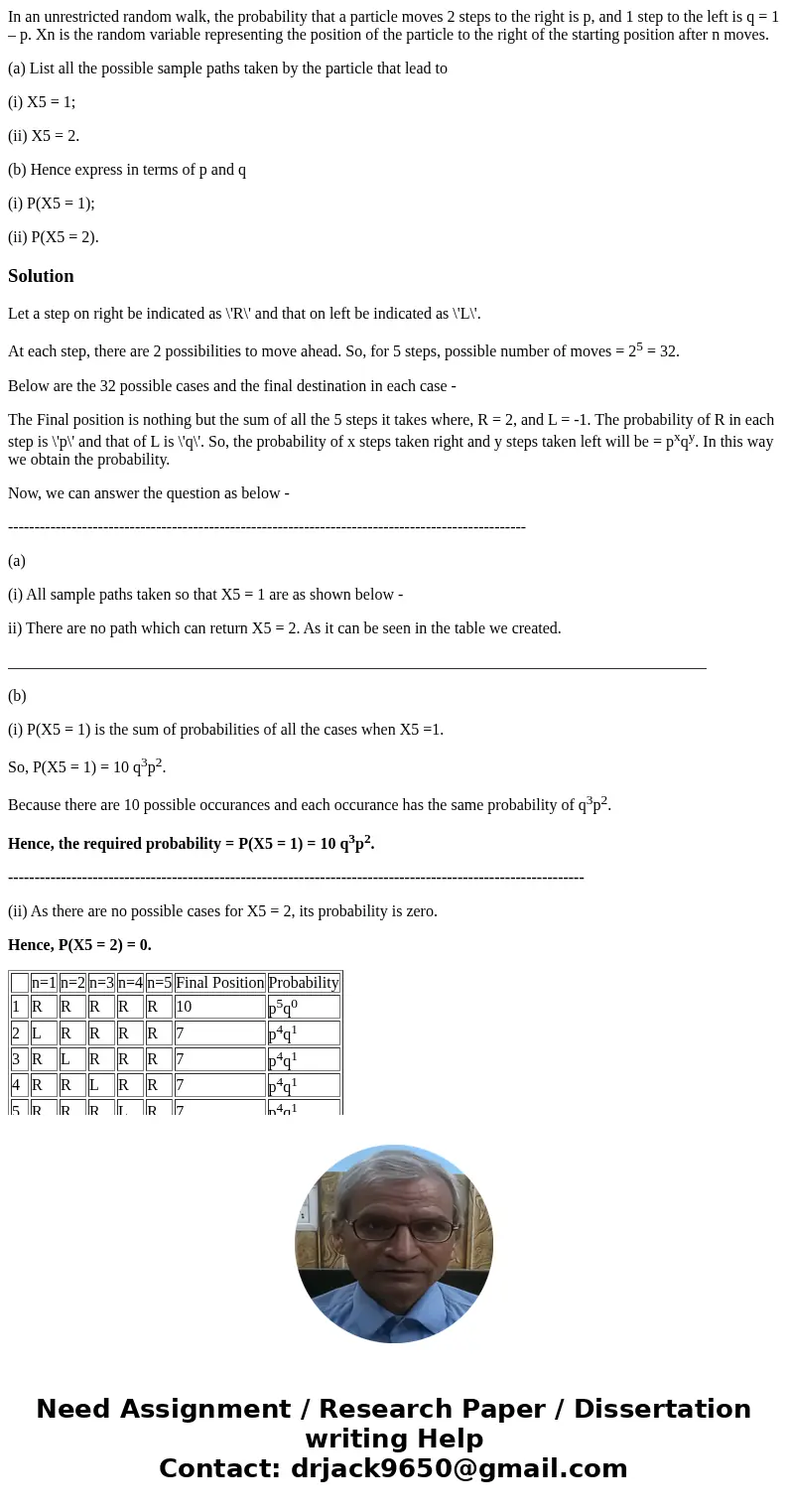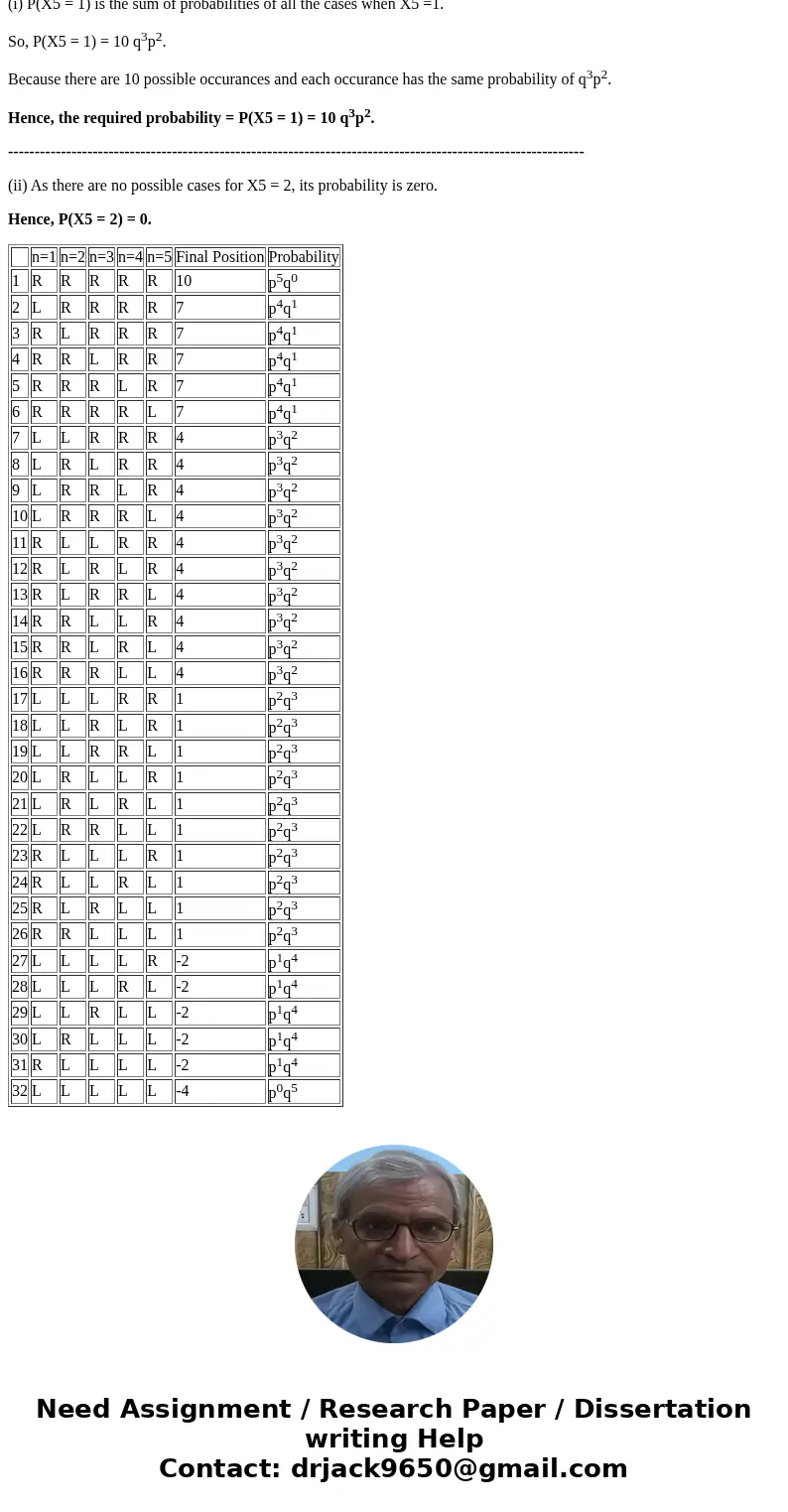In an unrestricted random walk the probability that a partic
In an unrestricted random walk, the probability that a particle moves 2 steps to the right is p, and 1 step to the left is q = 1 – p. Xn is the random variable representing the position of the particle to the right of the starting position after n moves.
(a) List all the possible sample paths taken by the particle that lead to
(i) X5 = 1;
(ii) X5 = 2.
(b) Hence express in terms of p and q
(i) P(X5 = 1);
(ii) P(X5 = 2).
Solution
Let a step on right be indicated as \'R\' and that on left be indicated as \'L\'.
At each step, there are 2 possibilities to move ahead. So, for 5 steps, possible number of moves = 25 = 32.
Below are the 32 possible cases and the final destination in each case -
The Final position is nothing but the sum of all the 5 steps it takes where, R = 2, and L = -1. The probability of R in each step is \'p\' and that of L is \'q\'. So, the probability of x steps taken right and y steps taken left will be = pxqy. In this way we obtain the probability.
Now, we can answer the question as below -
--------------------------------------------------------------------------------------------------
(a)
(i) All sample paths taken so that X5 = 1 are as shown below -
ii) There are no path which can return X5 = 2. As it can be seen in the table we created.
________________________________________________________________________________________
(b)
(i) P(X5 = 1) is the sum of probabilities of all the cases when X5 =1.
So, P(X5 = 1) = 10 q3p2.
Because there are 10 possible occurances and each occurance has the same probability of q3p2.
Hence, the required probability = P(X5 = 1) = 10 q3p2.
-------------------------------------------------------------------------------------------------------------
(ii) As there are no possible cases for X5 = 2, its probability is zero.
Hence, P(X5 = 2) = 0.
| n=1 | n=2 | n=3 | n=4 | n=5 | Final Position | Probability | |
| 1 | R | R | R | R | R | 10 | p5q0 |
| 2 | L | R | R | R | R | 7 | p4q1 |
| 3 | R | L | R | R | R | 7 | p4q1 |
| 4 | R | R | L | R | R | 7 | p4q1 |
| 5 | R | R | R | L | R | 7 | p4q1 |
| 6 | R | R | R | R | L | 7 | p4q1 |
| 7 | L | L | R | R | R | 4 | p3q2 |
| 8 | L | R | L | R | R | 4 | p3q2 |
| 9 | L | R | R | L | R | 4 | p3q2 |
| 10 | L | R | R | R | L | 4 | p3q2 |
| 11 | R | L | L | R | R | 4 | p3q2 |
| 12 | R | L | R | L | R | 4 | p3q2 |
| 13 | R | L | R | R | L | 4 | p3q2 |
| 14 | R | R | L | L | R | 4 | p3q2 |
| 15 | R | R | L | R | L | 4 | p3q2 |
| 16 | R | R | R | L | L | 4 | p3q2 |
| 17 | L | L | L | R | R | 1 | p2q3 |
| 18 | L | L | R | L | R | 1 | p2q3 |
| 19 | L | L | R | R | L | 1 | p2q3 |
| 20 | L | R | L | L | R | 1 | p2q3 |
| 21 | L | R | L | R | L | 1 | p2q3 |
| 22 | L | R | R | L | L | 1 | p2q3 |
| 23 | R | L | L | L | R | 1 | p2q3 |
| 24 | R | L | L | R | L | 1 | p2q3 |
| 25 | R | L | R | L | L | 1 | p2q3 |
| 26 | R | R | L | L | L | 1 | p2q3 |
| 27 | L | L | L | L | R | -2 | p1q4 |
| 28 | L | L | L | R | L | -2 | p1q4 |
| 29 | L | L | R | L | L | -2 | p1q4 |
| 30 | L | R | L | L | L | -2 | p1q4 |
| 31 | R | L | L | L | L | -2 | p1q4 |
| 32 | L | L | L | L | L | -4 | p0q5 |


 Homework Sourse
Homework Sourse